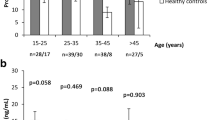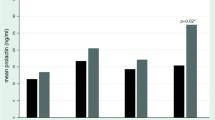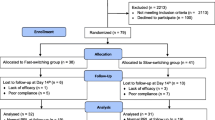Summary
Neuroleptic drugs may exert their antipsychotic effect by interference with central dopaminergic mechanisms. Tuberoinfundibular dopaminergic neurons may also be affected, which will increase prolactin secretion from the pituitary. Accordingly, a study has been made in 23 patients with acute paranoid psychosis, treated with thioridazine, of repeated ratings of psychiatric symptoms (CPRS) and of serum prolactin concentration. There was a close correlation between the serum concentration of prolactin and low doses of thioridazine, but at higher doses the increase in prolactin level gradually levelled off. At a given dose the prolactin response to thioridazine showed large interindividual variation and female patients had higher serum prolactin concentrations than males. The prolactin response to thioridazine was unaffected by time of treatment, age or body weight. In individual patients a correlation was found between serum prolactin level and amelioration of psychiatric symptoms, as reflected by the psychiatric rating score (p<0.001). After normalization of the data, the same relationship was also found for the entire group of patients. The dose-response relationship of prolactin to thioridazine showed saturation kinetics and linear transformation by a Woolfe-plot was done. Therefore, it appears possible to predict the thioridazine dose that would give the maximal prolactin response (and maximal clinical effect) and thereby optimize the regimen of antipsychotic medication in the individual patient.
Similar content being viewed by others
References
Åsberg, M., Montgomery, S. A., Perris, C., Schalling, D., Sedvall, G.: A Comprehensive Psychopathological Rating Scale. Acta Psychiat. Scand. Suppl.271 (1978)
Axelsson, R., Mårtensson, E.: Serum concentration and elimination from serum of thiordiazine in psychiatric patients. Curr. Ther. Res.19, 242–265 (1976)
Axelsson, R., Forsman, A., Wendestam, C., Öhman, R.: A biomathemathic model for prolactin response to dopamine-blocking agents in man. Clin. Pharmacol. Ther. (submitted) (1978)
Carlsson, A.: The effect of neuroleptic drugs on brain catecholamine metabolism, in: Antipsychotic drugs, pharmacodynamics and pharmacokinetics. G. Sedvall, B. Uvnäs, Y. Zotterman (eds.) p. 99–104. Oxford: Pergamon Press 1975
Dixon, M., Webb, E.: Enzymes, London: Longmans, Green 1964
Forsman, A., Öhman, R.: Pharmacokinetic studies on haloperidol in man. Curr. Ther. Res.20, 319–336 (1976)
Hogarty, G., Goldberg, S., Schooler, N., Ulrich, R.: Drug and sociotherapy in the aftercare of schizophrenic patients. Arch. gen. Psychiatry31, 603–618 (1974)
Kolakowska, T., Wiles, D. H., McNeilly, A., Gelder, M.: Correlation between plasma levels of prolactin and chlorpromazine in psychiatric patients. Psychol. Med.5, 214–216 (1975)
May, P. R.: Treatment of schizophrenia. A comparative study of five treatment methods. New York: Science House 1968
Meites, J., Clemens, J.: Hypothalamic control of prolactin secretion. Vitam. Horm.30, 165–221 (1972)
McNeilly, A.: Radioimmunoassay of human prolactin. Proc. Roy. Soc. Med.66, 863–864 (1973)
Noel, G., Suh, H., Stone, G., Frantz, A.: Human prolactin and growth hormone release during surgery and other conditions of stress. J. clin. Endocrinol. Metab.35, 840–851 (1972)
Öhman, R., Larsson, M., Nilsson, I. M., Engel, J., Carlsson, A.: Neurometabolic and behavioural effects of haloperidol in relation to drug levels in serum and brain. Naunyn-Schmiedebergs Arch. Pharmakol.299, 105–114 (1977)
Sachar, E. J., Gruen, P. H., Karasu, T. B., Altman, N., Frantz, A. G.: Thioridazine stimulates prolactin secretion in man. Arch. Gen. Psychiatry32, 885–886 (1975)
Sachar, E.: Personal communication
Salzman, C., Kachansky, G., Shader, R.: Rating scales for geriatric. psychopharmacol. Bull.8, 3–22 (1972)
Sedvall, G.: Personal communication
Snyder, S.: Catecholamines in the brain as mediators of amphetamine psychoses. Arch. Gen. Psychiatry27, 169–179 (1972)
Thorell, J. I., Johansson, B. G.: Enzymatic iodination of polypeptides with125I to high specific activity. Biochem. Biophys. Acta251, 363–369 (1971)
Turkington, R. W.: Prolactin secretion in patients treated with various drugs. Arch. intern. Med.130, 349–354 (1972)
Ungerstedt, U.: Stereotaxic mapping of the monoamine pathways in the rat brain. Acta physiol. scand. Suppl.367, 1–48 (1971)
Wilson, R., Hamilton, J., Boyns, W., Forrest, P., Cole, E., Boyns, A., Griffiths, K.: The effect of long term phenothiazine therapy on plasma prolactin. Br. J. Psychiat.127, 71–74 (1975)
Author information
Authors and Affiliations
Rights and permissions
About this article
Cite this article
Öhman, R., Axelsson, R. Relationship between prolactin response and antipsychotic effect of thioridazine in psychiatric patients. Eur J Clin Pharmacol 14, 111–116 (1978). https://doi.org/10.1007/BF00607441
Received:
Accepted:
Issue Date:
DOI: https://doi.org/10.1007/BF00607441




